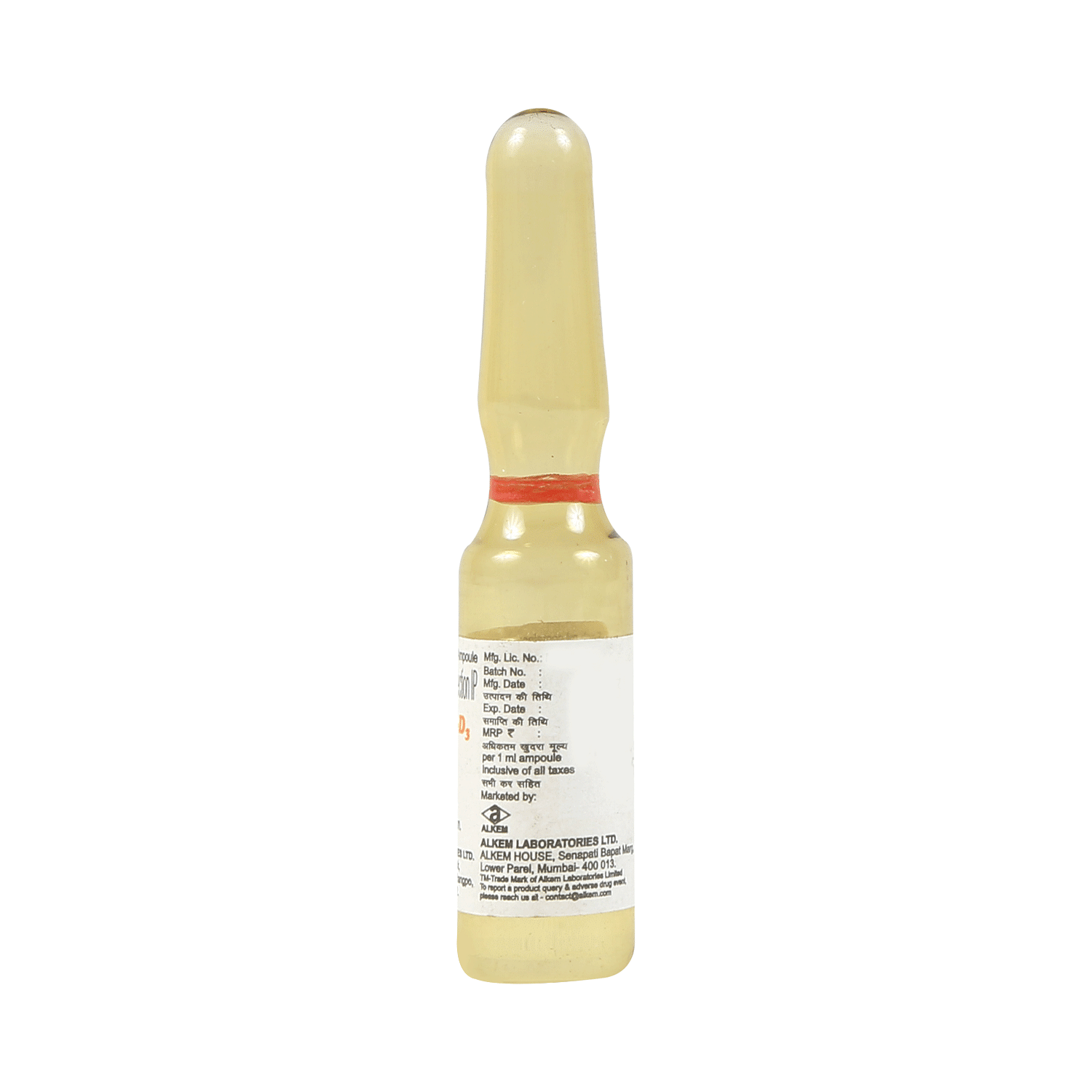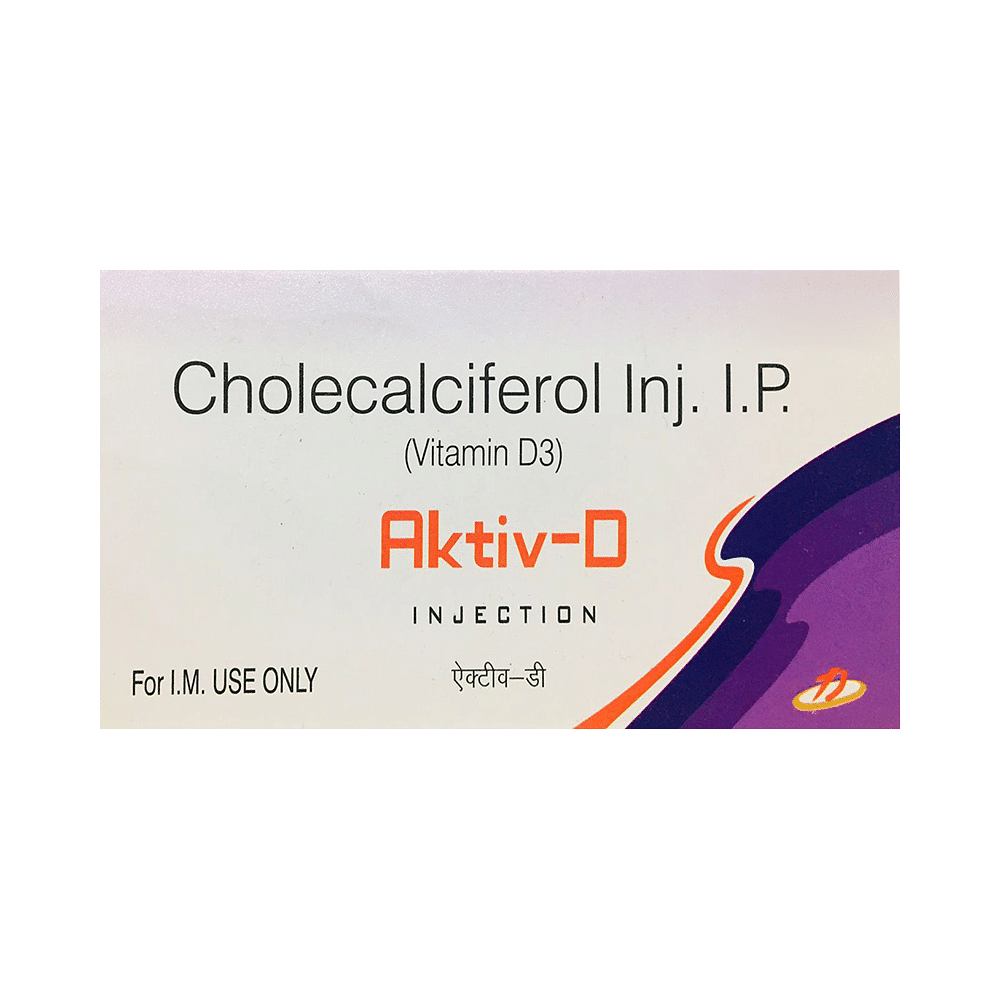
Calcidoc-D3 6L Injection
Manufacturer
Morepen Laboratories Ltd
Salt Composition
Vitamin D3 (60000IU)
Key Information
Short Description
Calcidoc-D3 6L Injection helps your body to absorb a mineral called calcium, which is important for maintaining strong bones. This medicine is used if your diet does not provide enough vitamin D and may be used to treat certain bone conditions such as thinning of the bones (osteoporosis).
Dosage Form
Injection
Introduction
Calcidoc-D3 6L Injection is given under the supervision of a healthcare professional and should not be self-administered. You should take it regularly to get the most benefit from it. If you are using it to treat osteoporosis you will be prescribed other medicines as well. This medicine may be only part of a complete program of treatment that also includes making changes to your diet and taking calcium and vitamin supplements. Learn about the foods you should eat to make sure you get enough calcium and vitamin D in your diet.
Directions for Use
Your doctor or nurse will give you this medicine. Kindly do not self administer.
How it works
Calcidoc-D3 6L Injection is a form of vitamin D. It raises vitamin D levels in your blood. This in turn raises calcium levels in your blood by helping you absorb more calcium from food.
Quick Tips
Get enough sun exposure 10-30 minutes thrice a week. Light-skinned: 20-30 minutes of sun exposure. Dark-skinned: 30-40 minutes of sun exposure. Eat vitamin D rich diet like egg yolk, mushrooms, cheese, milk, butter, fortified food and oily fish. Do not take antacids or any other medication 2 hours before or after taking Calcidoc-D3 6L Injection.
Related Medicines

Uprise-D3 6L Injection

Aktiv-D Injection

Caltouch 6 Injection

Vcor D 60000IU Injection

Sep D Injection

D3 60000IU Injection

Kridol-D3 Injection

Calwil D3 60000IU Injection
Frequently asked questions
What are the benefits of taking Calcidoc-D3 6L Injection?
Calcidoc-D3 6L Injection plays a vital role in maintaining bone health, supporting the immune system, brain, and nervous system. It also contributes to regulating insulin levels and promoting cardiovascular health by supporting heart and blood vessel function.
At what time of day should I take Calcidoc-D3 6L Injection?
The timing of Calcidoc-D3 6L Injection administration is flexible. You can take it at any time that's convenient for you, either morning or night. However, further research on optimal timings isn't readily available. It's crucial to adhere to your doctor's instructions and seek advice if unsure.
How is Calcidoc-D3 6L Injection administered?
Calcidoc-D3 6L Injection should be administered under the direct supervision of a qualified healthcare professional or doctor, as self-administration could pose risks. The dosage will vary depending on your specific medical condition and will be determined by your physician. Always follow your doctor's instructions carefully to optimize treatment effectiveness.
Who should not take Calcidoc-D3 6L Injection?
Individuals with a history of allergies to cholecalciferol should avoid Calcidoc-D3 6L Injection. This medication isn't recommended for patients experiencing high calcium levels in the blood or if there is evidence of calcium in their urine. Additionally, its use should be avoided in individuals with pre-existing kidney stones or severe kidney problems.
What happens if I take too much Calcidoc-D3 6L Injection?
Long-term overexposure to Calcidoc-D3 6L Injection may result in elevated calcium levels (hypercalcemia). This can lead to various symptoms, including weakness, fatigue, nausea, vomiting, diarrhea, sluggishness, kidney stones, increased blood pressure, and growth retardation in children. It's crucial to seek immediate medical attention if you experience any of these adverse effects.
How much Vitamin D3 should I take daily?
Calcidoc-D3 6L Injection provides a form of vitamin D used as a supplement for patients with vitamin D deficiency. The recommended daily intake of Vitamin D3 is typically 4,000 IU. However, dietary deficiencies may necessitate additional supplementation ranging from 1,000 to 3,000 IU.
What happens if Vitamin D3 is low?
Low levels of Vitamin D3 are associated with rickets in children and osteomalacia in adults. Vitamin D deficiency increases the risk of developing diabetes type 1, high blood pressure, depression, certain types of cancers, and osteoporosis.


